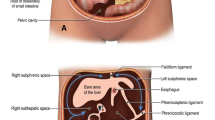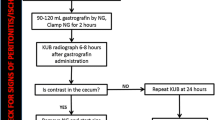Abstract
Acute colonic pseudoobstruction (ACPO) is a clinical condition of acute large bowel obstruction without mechanical blockage. ACPO occurs most often in hospitalized patients with serious underlying medical and surgical conditions. ACPO is an important cause of morbidity and mortality. The pathogenesis of ACPO is not completely understood but likely results from an imbalance in the autonomic regulation of colonic motor function. Metabolic or pharmacologic factors, as well as spinal or retroperitoneal trauma, may alter the autonomic regulation of colonic function, leading to excessive parasympathetic suppression or sympathetic stimulation. This imbalance results in colonic atony and pseudoobstruction. Early recognition and appropriate management are critical to minimizing morbidity and mortality. The mortality rate is estimated at 40% when ischemia or perforation occurs. The best documented treatment of ACPO is intravenous neostigmine, which leads to prompt decompression in the majority of patients after a single infusion. In patients failing or having contraindications to neostigmine, colonoscopic decompression is the active intervention of choice. Surgery is reserved for those with overt peritonitis or perforation.
Similar content being viewed by others
References
Saunders MD, Kimmey MB: Management of acute colonic pseudo-obstruction (Ogilvie’s syndrome). In Evidenced-Based Gastroenterology and Hepatology, edn 2. Edited by McDonald JWD. Dallas, TX: JA Majors; 2004:1–7.
Vanek VW, Al-Salti M: Acute pseudo-obstruction of the colon (Ogilivie’s syndrome): an analysis of 400 cases. Dis Colon Rectum 1986, 29:203–210. A large retrospective series that provides much of the information used clinically in acute colonic pseudoobstruction in regard to patient outcome and treatment variables.
Dorudi S, Berry AR, Kettlewell MGW: Acute colonic pseudoobstruction. Br J Surg 1992, 79:99–103.
Jetmore AB, Timmcke AE, Gathright BJ Jr, et al.: Ogilvie’s syndrome: colonoscopic decompression and analysis of predisposing factors. Dis Colon Rectum 1992, 35:1135–1142.
Sheikh RA, Yasmeen S, Pauly MP, et al.: Pseudomembranous colitis without diarrhea presenting clinically as acute intestinal pseudo-obstruction. J Gastroenterol 2001, 36:629–632.
Rex DK: Acute colonic pseudo-obstruction (Ogilvie’s syndrome). Gastroenterologist 1994, 2:223–2238.
Johnson CD, Rice RP: The radiographic evaluation of gross cecal distention. Am J Radiol 1985, 145:1211–1217.
Eisen GM, Baron TH, Dominitiz JA, et al.: Acute colonic pseudo-obstruction. Gastrointest Endosc 2002, 56:789–792. Evidenced-based guidelines published by the Standards of Practice Committee for the American Society of Gastrointestinal Endoscopy (ASGE).
Sloyer AF, Panella VS, Demas BE, et al.: Ogilvie’s syndrome: successful management without colonoscopy. Dig Dis Sci 1988, 33:1391–1396.
Wanebo H, Mathewson C, Conolly B: Pseudo-obstruction of the colon. Surg Gynecol Obstet 1971, 133:44–48.
Meyers MA: Colonic ileus. Gastrointest Radiol 1977, 2:37–40.
Bachulis BL, Smith PE: Pseudo-obstruction of the colon. Am J Surg 1978, 136:66–72.
Baker DA, Morin ME, Tan A, et al.: Colonic ileus: indication for prompt decompression. JAMA 1979, 241:2633–2634.
Loftus CG, Harewood GC, Baron TH: Assessment of predictors of response to neostigmine for acute colonic pseudoobstruction. Am J Gastroenterol 2002, 97:3118–3122. A recent retrospective analysis of 151 patients with ACPO. The study confirmed that most patients respond to conservative therapy (77%) and that neostigmine is effective (prompt evacuation in 89%). However, neostigmine appeared to be underutilized in patients who did not have a contraindication to its use (only one of 16 nonresolvers who did not receive neostigmine had a contraindication to its use).
Ponec RJ, Saunders MD, Kimmey MB: Neostigmine for the treatment of acute colonic pseudo-obstruction. N Engl J Med 1999, 341:137–141. The only prospective, randomized, controlled trial in ACPO. Neostigmine was superior to placebo in achieving a clinical response with prompt evacuation of the colon, leading to a reduction in cecal diameter and abdominal girth. Of the 18 patients who received neostigmine, either initially or during open-label treatment, 17 (94%) had an immediate clinical response and two (11%) had recurrent colonic dilation.
Law NM, Bharucha AE, Undale AS, et al.: Cholinergic stimulation enhances colonic motor activity, transit, and sensation in humans. Am J Physiol Gastrointest Liver Physiol 2001, 28:G1228-G1237.
Neely J, Catchpole B, Ileus: the restoration of alimentary-tract motility by pharmacologic means. Br J Surg 1971, 58:21–28.
Aquilonius SM, Hartvig P: Clinical pharmacokinetics of cholinesterase inhibitors. Clin Pharmacokinet 1986, 11:236–249.
Cronnelly R, Stanski DR, Miller RD, et al.: Renal function and the pharmacokinetics of neostigmine in anesthetized man. Anesthesiology 1979, 51:222–226.
Hutchinson R, Griffiths C: Acute colonic pseudo-obstruction: a pharmacologic approach. Ann R Coll Surg Engl 1992, 74:364–367.
Stephenson BM, Morgan AR, Salaman JR, et al.: Ogilvie’s syndrome: a new approach to an old problem. Dis Colon Rectum 1995, 38:424–427.
Turegano-Fuentes F, Munoz-Jimenez F, Del Valle-Hernandez E, et al.: Early resolution of Ogilvie’s syndrome with intravenous neostigmine: a simple, effective treatment. Dis Colon Rectum 1997, 40:1353–1357.
Trevisani GT, Hyman NH, Church JM: Neostigmine: safe and effective treatment for acute colonic pseudo-obstruction. Dis Colon Rectum 2000, 43:599–603.
Paran H, Silverberg D, Mayo A, et al.: Treatment of acute colonic pseudo-obstruction with neostigmine. J Am Coll Surg 2000, 190:315–318.
Abeyta BJ, Albrecht RM, Schermer CR: Retrospective study of neostigmine for the treatment of acute colonic pseudoobstruction. Am Surg 2001, 67:265–268.
Armstrong DN, Ballantyne GH, Modlin IM: Erythromycin for reflex ileus in Ogilvie’s syndrome. Lancet 1991, 337:378.
Bonacini M, Smith OJ, Pritchard T: Erythromycin as therapy for acute colonic pseudo-obstruction (Ogilvie’s syndrome). J Clin Gastroenterol 1991, 13:475–476.
MacColl C, MacCannell KL, Baylis B, et al.: Treatment of acute colonic pseudo-obstruction (Ogilvie’s syndrome) with cisapride. Gastroenterology 1990, 98:773–776.
Camilleri M: Review article: Tegaserod. Aliment Pharmacol Ther 2001, 15:277–289.
Fiorto JJ, Schoen RE, Brandt LJ: Pseudo-obstruction associated with colonic ischemia: successful management with colonoscopic decompression. Am J Gastroenterol 1991, 86:1472–1476.
Rex DK: Colonoscopy and acute colonic pseudo-obstruction. Gastrointest Endosc Clin N Am 1997, 7:499–508. A comprehensive review of the literature evaluating colonoscopic decompression in ACPO. Among 292 reported patients treated by colonoscopy, 69% had a successful initial decompression. However, recurrence rates were 40% when no decompression tube was placed. To improve therapeutic benefit, tube placement is strongly recommended.
Geller A, Petersen BT, Gostout CJ: Endoscopic decompression for acute colonic pseudo-obstruction. Gastrointest Endosc 1996, 44:144–15.
vanSonnenberg E, Varney RR, Casola G, et al.: Percutaneous cecostomy for Ogilvie’s syndrome: laboratory observations and clinical experience. Radiology 1990, 175:679–682.
Chevallier P, Marcy PY, Francois E, et al.: Controlled transperitoneal percutaneous cecostomy as a therapeutic alternative to the endoscopic decompression for Ogilvie’s syndrome. Am J Gastroenterol 2002, 97:471–474.
Ramage JI, Baron TH: Percutaneous endoscopic cecostomy: a case series. Gastrointest Endosc 2003, 57:752–5. A small cases series in patients with colonic pseudo-obstruction (both acute and chronic) showing the safety and efficacy of this technique in the management of these patients. This approach could be considered in patients not responding to neostigmine or colonoscopy with decompression tube placement and who are at high risk for surgery.
Author information
Authors and Affiliations
Rights and permissions
About this article
Cite this article
Saunders, M.D. Acute colonic pseudoobstruction. Curr Gastroenterol Rep 6, 410–416 (2004). https://doi.org/10.1007/s11894-004-0059-5
Issue Date:
DOI: https://doi.org/10.1007/s11894-004-0059-5




